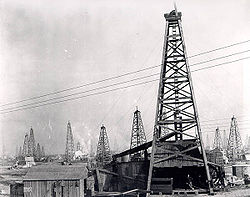Oil field
An oil field or oil tanker is an area with an abundance of wells from which hydrocarbons are extracted from the subsoil. Because underground oil-bearing formations (oil fields) can extend over large areas, sometimes several hundred square kilometres, full development involves several wells or platforms spread over an area. In addition, there may be exploratory wells that investigate the limits, pipelines to transport the oil to any place and support premises.
Proximity
Often you can see wells located very close to each other (just a few meters). In this case, they are wells drilled at different depths, due to the arrangement of the deposits in layers or basins parallel to each other and separated by impermeable strata.
Exploitation
Since an oil field can be quite remote from civilization, setting it up can be an extremely complicated exercise most of the time, logistics wise. For example, workers have to do their work there for months or years, and require accommodation. Also, accommodation and equipment requires electricity and water. Pipes in cold areas may need to be heated. An excess of natural gas makes it necessary to flare it if there is no way to make use of it, which requires a furnace, warehouses, and pipelines to transport it from the well to the furnace.
Thus, the typical oil field looks like a small self-sufficient town in the middle of a landscape dotted with oil rigs or pump jacks, known as "head donkeys& #3. 4; (nodding donkeys), due to their moving arm, which are also known as seesaws in some countries. Several companies, such as Bechtel and Halliburton, have organizations that specialize in large-scale construction of the infrastructure required to profitably operate a field. In many cases, derricks are dismantled to use their parts for new drilling. In others, such as Lake Maracaibo, they are left in place, not only because of the higher cost of reusing them, but because they are still useful for some maintenance work.
There are more than 40,000 oil fields spread across the globe, both on land and offshore. The largest are the Ghawar Field in Saudi Arabia and the Burgan Field in Kuwait, with more than 60 billion barrels estimated in each. Most oil wells are much smaller. In the modern age, the location and known reserves of oil fields are a key factor in many geopolitical conflicts.
Contenido relacionado
Israel Space Agency
Conglomerate
North American Free Trade Agreement

